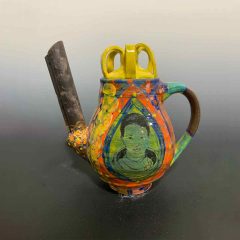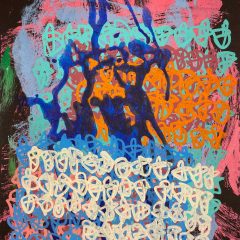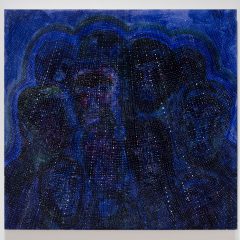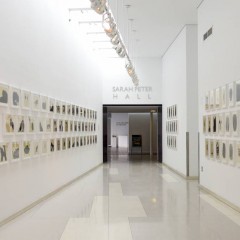—>Sam sees a show of more than 100 works, with no wall labels, and gets an immersion in the colorful creative world of outsider artists and those with training. –the Artblog editors———–>
The group exhibition Psychedelphia featuring 100 works by 40 Philadelphia artists, displays the diverse psychedelic sensibilities and styles of the artists, characterized by hallucinatory exploration of infinity and the complexity of experience. The show in Pageant: Soloveev’s intimate gallery features two- and three-dimentional works of various scales by established artists and some new to the scene. All of the works are gathered together on tables and on the walls, unlabeled and free to mix and mingle with one another, creating a fluid freedom for interaction. Threads of neon color, kinetic energies (both active and inert), fractal-like patterns, unexpected found objects, and human figuration keep these diverse pieces in conversation with one another. This potential for free association also speaks to a kind of communal artistic impulse and shared psychic energies.
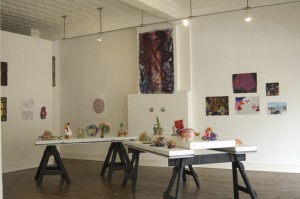
Geological/psychological works
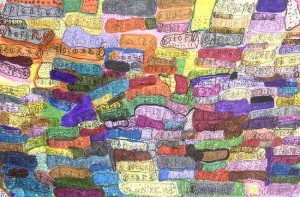
Two drawings by Jenny Cox feature seemingly random words in bright, multi-colored pouches, surrounded by tiny dots reminiscent of an illuminated Las Vegas marquee. Some words, like “before,” “why,” and “please,” repeat hauntingly throughout the compositions, sliding lugubriously between the irregular ovals created by each color. Because of the crude, wavy quality of the lettering and the diverse line quality, the literal meaning of each word dissolves somewhat into its surroundings, becoming a series of signs and symbols within a large and complex whole. The overall effect is simultaneously geological and biological, a precarious stack of strange fragments of language awkwardly united like organelles within the gelatinous walls of a cell, or a geologic map depicting the topographic exposure of rock. Cox combines the inherent awkwardness of hand-lettered print with the ultimate meaninglessness of disjointed language by dividing words in this way (even including her own name at the bottom). It’s a mesmerizing and dizzying array of vibrant color.
Sculptures that suggest animals and humans
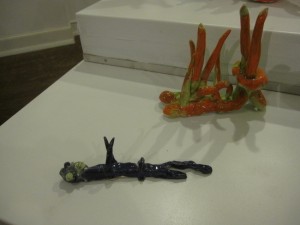
All of the ceramic sculptures by Brandon Spencer-Crawley, of which there are quite a few in this show, refer to human and animal figures in some way, whether through a delicate, arm-like tentacle or bulging orbs that appear as eyes on a vase. The playful approach to sculpted form using a variety of hand-building techniques brings a touch of Alexander Calder-esque circus sensibility to the three-dimensional offerings of “Psychedelphia.” Spencer-Crawley’s little figures appear as expressive and bizarre interpretations of the human body or face among a variety of more abstract pieces, capturing surprising gestures and acrobatic motion.
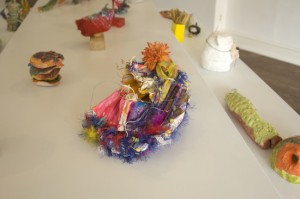
Also among the three-dimensional pieces are a number of colorful mixed media works by Deborah Clark and Kelly Brown, which offer both rich visual and tactile experiences. Clark’s sculptures, created from a combination of what appears to be an accordion manila binder, several kinds of fuzzy yarn, fabric flowers, and neon paint, are at once tense and explosive. The yarn serves to bind and augment the still shape of the paper, pulling it taut in some places and letting it fall open in others, while the neon palette gives the sculpture a paradoxical air of motionless vibration.
Totems hanging near the ceiling
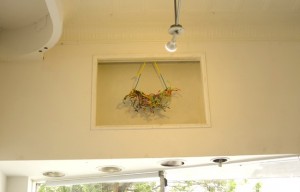
Exhibited high on the wall in alcoves near the ceiling, Brown has three sculptures, two hanging and one poised, totem-like, above the front door. They maintain the colors consistent throughout the show through the inclusion of neon painted beads and pipe cleaners, as well as the tension between binding, suspension, and free movement. The two hanging sculptures feature what looks like repurposed radiator grills as a matrix for a garden of spider-like tendrils that twist downward, casting hairy shadows onto the gallery wall. The combination of soft, fuzzy twine and stiff, shiny metal creates a feeling of pleasure to the imaginary touch; the sway and bounce of the sculptures also lends itself to the experience of this suggested sensation.
Motion-activated works activate the surrounding pieces
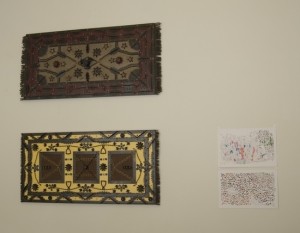
The only objects that are literally in motion at this show are Jacqueline Branson’s “rugs,” relatively flat sculptures made of computer parts and small pieces of machinery mounted on the wall. When activated, these parts spin and click with motion that spans both the face and the inside layer of the piece bringing the work alive both visually and sonically. Branson’s sculpture activates the works around it as well, from the frenetic dots in Tammy Byerly’s works on paper to the arching gestures in Jordan Graw’s painting “We All Thought He Was Nice” and the hulking, glacial separations in Paige Donovan’s abstract landscape. This unexpected possibility of motion within speaks to pieces throughout the show.
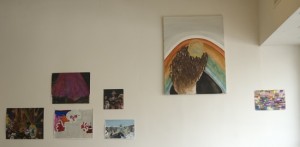
Many visions of reality
With over 100 works on display, “Psychedelphia” embraces many visions of reality including those from artists who are participants at the Center for Creative Works in Wynnewood, a day center for adults with developmental disabilities. Because there is no clear labeling of the works in the show, their work exists side by side with works from artists with traditional training and MFA degrees, allowing viewers to experience every work on the same purely visual and experiential level. While curator and Pageant: Soloveev owner Daniel Dalseth said he considered the individual works in this show on their artistic merit when selecting works for this summer invitational, he acknowledged that artists from the Center tap into the theme of “Psychedelphia” – a “creative sanctuary for the artistic psyche,” as he described it – in a unique and pure way.
“The work by the clients from the Center of Creative Works – it really is about this innate kind of inviolable, expressive tendency of the creative mind, that at its best, with trained artists, is inhibited,” Dalseth said. “A lot of times with contemporary practice you see that kind of impulse moderated by all the conceptual strategies and whatnot that people try to employ to figure their work out.”
“Psychedelphia” will be up at Pageant: Soloveev through the summer.
Photos by Jordan Graw and Sam Newhouse


